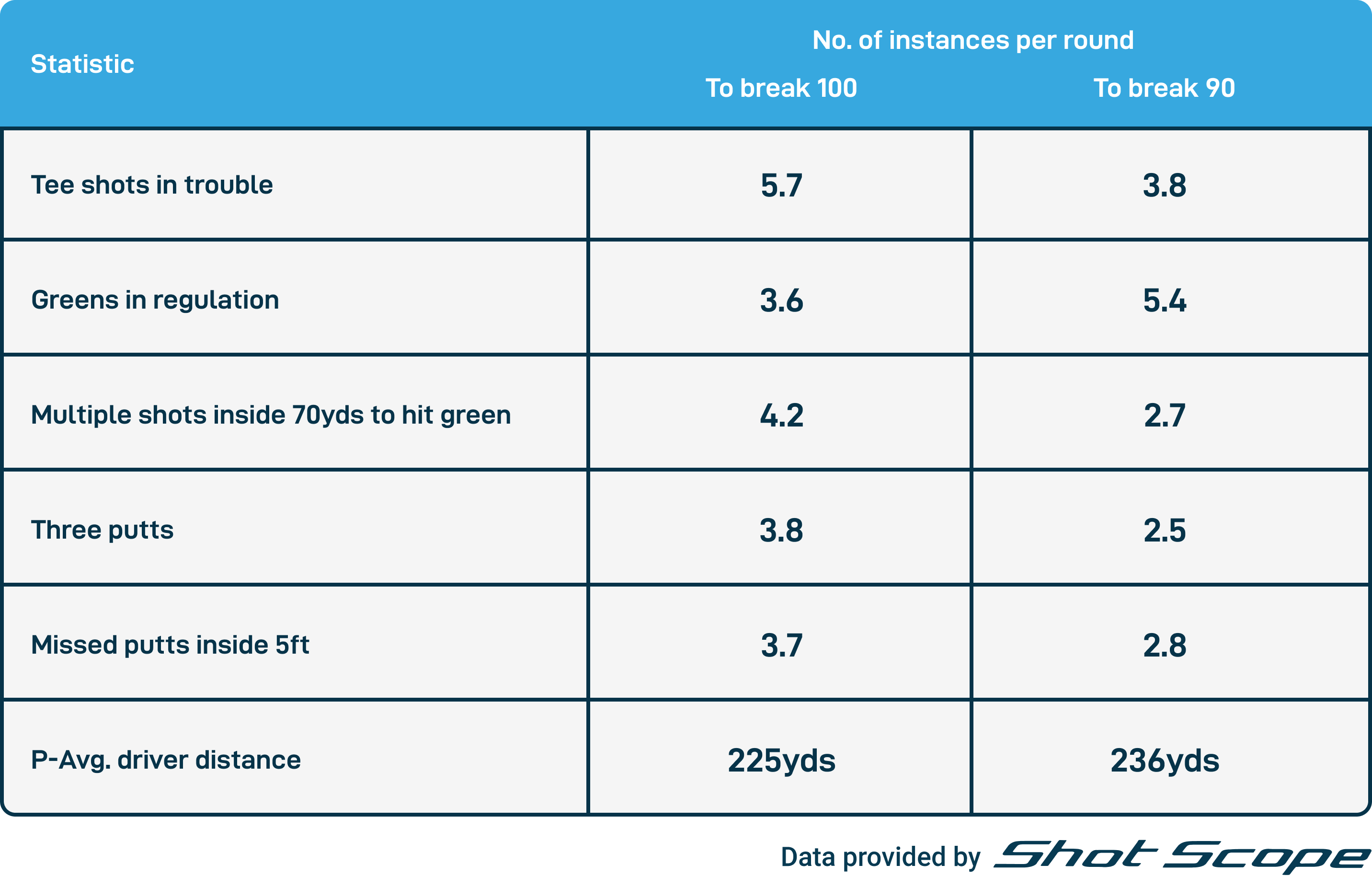You’ve conquered the triple-digit barrier and consistently broken 100. Nice work. Now it’s time to set your sights on the next milestone: shooting in the 80s.
Breaking 90 isn’t just about getting there once—it’s about making it a habit. The good news? The path from the mid-90s to the high 80s is clearer than you might think.
Our friends at Shot Scope have identified six key performance metrics that matter for golfers at every skill level. When we look at these stats specifically for golfers trying to break 90, clear patterns emerge that show exactly where you need to focus your improvement efforts. These aren’t obscure metrics that require a PhD in statistics to understand. They’re simple, trackable numbers that directly impact your scorecard.
The Shot Scope Six
- Number of tee shots in trouble
- Greens in regulation
- Multiple shots inside 70 yards to hit the green
- Number of three putts
- Missed putts inside 5 feet
- Driving distance
Before we dive into how to improve these numbers, let’s look at what a typical round in the 90s actually looks like.
What a 90s golfer looks like

The story these numbers tell is pretty clear: golfers who break 90 keep the ball in play off the tee, hit more greens and avoid big numbers on the scorecard.
Start with the tee shot
Here’s the thing about golf: it’s hard to score well when you’re constantly playing from the trees, the rough or worse. Golfers who break 90 average four troublesome tee shots per round compared to six for those stuck in the 90s.
That difference of two tee shots might not sound like much but think about it. Two fewer penalty shots. Two fewer times chipping out sideways. Two fewer holes where you’re behind the eight ball before you even reach your approach shot. Two fewer times seriously contemplating whether the beverage cart sells anything strong enough to erase the memory of that tee shot.
There’s also a confidence factor here that’s impossible to quantify but absolutely real. Nothing rattles your nerves quite like watching your golf ball disappear into the woods on the third hole. Keep the ball in play, and you’ll stay calmer, more focused and ultimately shoot lower scores.
The math is simple: it’s a lot easier to hit greens in regulation when you’re not in trouble a third of the time.

Hit more greens (and forget about the pin)
To break 90 consistently, you need to hit about 5.4 greens in regulation per round—nearly two more than the golfer shooting in the 90s. That correlation between fewer trouble shots and more greens in regulation? Not a coincidence.
Here’s why hitting greens matters so much: getting up and down is hard. The average golfer successfully converts up-and-down opportunities only one in three times. That means two-thirds of the time, you’re dropping shots when you miss the green.
Want to start hitting more greens tomorrow? Stop aiming at flags and start aiming at the middle of greens. I know it sounds boring, but boring golf often produces better scores. And here’s a key insight from the data: the typical 15-handicap golfer leaves half of their approach shots short of the green.
Take an extra club. Seriously. The back of the green is almost always better than the front edge or the bunker guarding it.
Eliminate the three-putt
To go from shooting in the 90s to the 80s, you need to have one fewer three-putt per round. That’s it. Just one.
If you want your scores to start with an eight, you can have no more than three three-putts in a round. While wayward tee shots might knock you off your stride confidence-wise, nothing gets the blood pressure rising quite like a three-putt.
The fix is actually pretty straightforward: work on your lag putting and (while you’re at it) get automatic from three feet and in.
On those long putts—20 feet and beyond—focus entirely on distance control. If you can consistently get your first putt inside three feet, you’ll virtually eliminate three-putts. Why? Because Shot Scope data shows that even a 25-handicap golfer makes nearly nine out of 10 putts from inside three feet.
Get dialed in on distance control and be confident draining those three-footers. Those are the putts that separate golfers who break 90 from those who don’t.
The bottom line
Small improvements in a few key areas can save you a surprising number of shots. You don’t need to overhaul your entire game or suddenly start hitting it like Dustin Johnson. You just need to:
- Keep two more tee shots in play per round
- Hit two more greens in regulation
- Eliminate one three-putt
Do those three things consistently and you’ll be well on your way to breaking 90 and staying there.

The Shot Scope Six isn’t an exhaustive list of every stat that matters in golf but these numbers are simple to track and deliver real results. If you want a seamless, subscription-free way to monitor these statistics and more than 100 other “tour-level” metrics, check out Shot Scope’s performance tracking products. They offer GPS watches, rangefinders and more to help you get the most out of your game.
Remember: Breaking 90 isn’t about perfection—it’s about avoiding the big mistakes that turn potential pars into double bogeys. Keep it simple, stay patient, and let the numbers guide your improvement.
Shot Scope is the Official On-Course Data Partner of MyGofSpy.
The post How To Break 90 (And Keep Breaking It) appeared first on MyGolfSpy.


